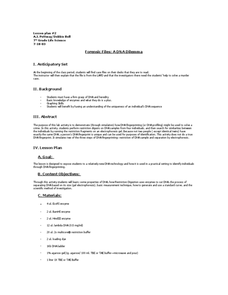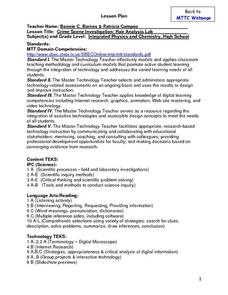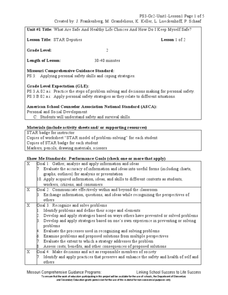Purdue University
The Case of the Pilfered Pin: A Measurement Inquiry Activity
Who pilfered the pin? Scholars practice measurement skills as they solve the mystery of a stolen pin. They measure length, temperature, and mass and determine which of select suspects committed the crime. During the STEM hands-on...
Curated OER
Who Done It?
Pick and choose which activities to include in this crime scene investigation. Junior detectives can examine fingerprints, DNA, blood samples, or bone structure. The plan suggests you have teams solve a mystery, but it does not give you...
Curated OER
Forensic Files: A DNA Dilemma
Seventh-graders come in to science class to find a file on their desks detailing a crime to be solved! As a demonstration, you simulate the restriction of DNA samples and separate them by electrophoresis. From the gel, learners can...
Shmoop
ELA - Literacy.CCSS.ELA-Literacy.RST.9-10.6
Key to understanding scientific or technical texts is identifying the underlying question the author is attempting to answer. Provide your young scientists with an opportunity to practice identifying these questions and the procedures...
Curated OER
MUD-Research Center Lesson Plan
Students research chosen sub-topics on mud. They research topics such as idioms about mud, crime solving using tire tracks and animal homes made of mud. Afterward, they choose a presentation method such as a Word document, PowerPoint...
Curated OER
Crime Scene Investigation: Hair Analysis Lab
Students participate in a hair analysis lab. Using a digital microscope, students compare and contrast hair samples. They determine if the hair samples are human or animal. After completing lab results sheets, students share their...
Curated OER
STAR Deputies
Second graders engage in a lesson that is about the sharing of following rules to follow the law. They concentrate on the making of safe choices. Students use the examples to have class discussion. They also role play scenarios of making...
Center for History Education
Road to Revolution: How did Actions and Responses Lead to an Independent United States?
Using primary sources, maps, and an interactive M&M game, young historians examine the American revolution as if they were detectives trying to solve a crime. Resource includes graphic organizers and a final writing prompt to aid...
Curated OER
Missing Masterpieces
Students investigate a fictitious crime involving stolen art masterpieces. They work collaboratively in teams to solve the fictitious crime. Students return the stolen paintings in a Microsoft PowerPoint "portfolio" to their owner. They...
Curated OER
The Case of Similar Substances
Students solve a crime mystery using chemical tests. They review the crime scenario and then become familiar with the procedure and results for two tests used to identify unknown powders. They perform the tests on the crime samples and...
Curated OER
CSI Lesson Plans Can Turn Students Into Learning Detectives
Children learn to use the methods of good detection for solving a crime, and even analyzing literature.
Curated OER
Infrared Spectroscopy in Forensic Chip Analysis
Students analyze spectrums as related to forensics. In this chemistry lesson, students define spectroscopy and discuss its use in chemistry. They discuss how the Forensic Paint Chip is used to help solve crimes.
Curated OER
Interdisciplinary Applications of Chemistry Through Engineering in Modern Medicine
Students explore the different techniques used in forensic science. In this chemistry lesson plan, students investigate a fictional crime and identify the culprit. They create a brochure or collage career bulletin.
Curated OER
Who Dun It?
In this proofs by contradiction activity, students solve 1 word problem about a crime. Students use proof by contradiction to determine the criminal in the word problem.
Curated OER
Cardiac Arrest! Using Forensics to Investigate Cardiovascular Anatomy and Function
Students identify the different parts and functions of the cardiovascular system. In this forensics lesson, students collect and analyze evidence on a fictional crime. They describe different causes of cardiac arrest.
Curated OER
Who Did It?
Students apply the concepts from forensic science lessons to do a lab. They solve a mystery using experimentation and observation. They write a technically correct lab report.
Curated OER
Using Logic
For this using logic worksheet, students are given a variety of methods used to solve problems based on logic. They read about cause and effect relationships and finding solutions to problems. They are given three problems to solve using...
Curated OER
Soil Detectives: The Case of the Lost Friends
Young scholars show how soil varies across the landscape, they explain how soil can be used to solve mysteries. Pupils are introduced to techniques that would be used to distinguish soils from different places.
Curated OER
Who Is It?/Who Done It?
Students conduct an experiment that allows them to assess individual differences in random DNA sequences and apply those differences when solving a forensic problem. After discussing the polymerase chain reaction and its use to identify...
Curated OER
Statistics and the Truth
For this math worksheet, students solve a word problem related to illegal use of a firearm arrests in Hemlock County. Students read two candidates' statements and decide which is mathematically correct.
Curated OER
Police Use MySpace
Students interview law enforcement officials concerning their use of the Internet to catch criminals. They research how MySpace operates. They interview staff at MySpace and its uses. They write a news feature about a criminal case...
Curated OER
Fingerprinting
Students list and describe the three types of fingerprint patterns. They list and describe three layers of fingerprints that can be made. They explain why we leave fingerprints.
Curated OER
Ink Analysis and Thin Layer Chromatography
Young scholars explain the process of TLC. They identify at least three components of ink. They analyze data and make conclusions based on laboratory observations.
Curated OER
Mock Investigation
Students explore detective investigations. In this introduction to mysteries lesson, students role play eye witnesses and investigators related to a "crime" committed in their classroom. Students collect evidence and record information,...

























